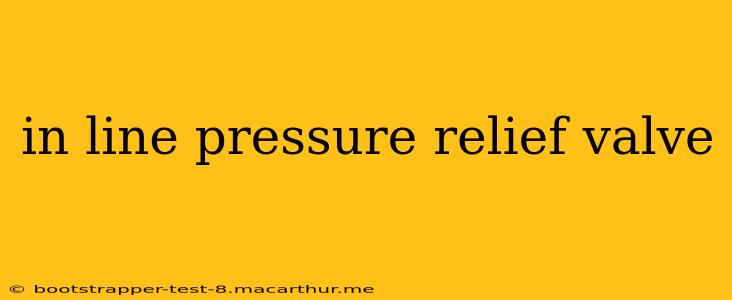In-line pressure relief valves are crucial safety devices used in various hydraulic and pneumatic systems. They prevent excessive pressure buildup that could damage components or cause hazardous situations. This comprehensive guide will explore their function, types, applications, and selection criteria.
What is an In-Line Pressure Relief Valve?
An in-line pressure relief valve, also known as a pressure relief valve (PRV) or safety relief valve (SRV), is a flow control device installed directly in a pipeline. When system pressure exceeds a preset value, the valve opens automatically, diverting excess fluid to a safe location, thereby protecting the system from overpressure. This differs from other pressure-regulating valves that simply maintain a specific pressure. The in-line PRV's primary function is protection, not precise pressure regulation.
How Does an In-Line Pressure Relief Valve Work?
The operation is relatively straightforward. The valve incorporates a spring-loaded poppet or diaphragm. When the system pressure surpasses the predetermined setting, the force exerted on this element overcomes the spring force, causing the valve to open. Fluid then flows through the valve, relieving the pressure. Once the pressure drops below the setpoint, the spring force closes the valve, restoring the system to normal operation.
Types of In-Line Pressure Relief Valves
Several factors influence the type of in-line pressure relief valve needed for a specific application. These factors include pressure rating, flow capacity, fluid compatibility, and mounting style. Common types include:
- Direct Acting Valves: These valves respond directly to the system pressure. They are simple, reliable, and relatively inexpensive.
- Pilot-Operated Valves: These valves require a smaller pilot pressure to assist in opening the main valve. They're suitable for high-flow applications or situations where a precise pressure setting is needed.
- Spring-Loaded Valves (most common): The spring provides the force resisting the pressure. The spring tension determines the cracking pressure.
- Balanced Valves: These valves are designed to minimize the effect of downstream pressure on the valve's operation. This ensures consistent performance regardless of pressure fluctuations downstream.
What are the Applications of In-Line Pressure Relief Valves?
In-line pressure relief valves find wide application across diverse industries. Some key examples include:
- Hydraulic Systems: Protecting hydraulic pumps, cylinders, and other components from overpressure.
- Pneumatic Systems: Preventing overpressure in compressed air systems used in manufacturing and automation.
- Chemical Processing: Safeguarding equipment and personnel from pressure surges in chemical plants.
- Oil and Gas: Protecting pipelines and equipment from excessive pressure in oil and gas extraction and processing.
What is the Difference Between a Pressure Relief Valve and a Pressure Reducing Valve?
This is a frequently asked question. While both manage pressure, their functions differ significantly. A pressure relief valve (PRV) protects a system from overpressure by venting excess fluid. A pressure reducing valve (PRV) maintains a constant lower downstream pressure regardless of upstream fluctuations. The PRV acts as a safety device; the pressure reducing valve acts as a pressure regulator.
How Do I Select the Right In-Line Pressure Relief Valve?
Selecting the correct valve depends on several crucial factors:
- Maximum System Pressure: The valve's pressure setting must exceed the maximum anticipated system pressure.
- Required Flow Capacity: The valve must be able to handle the maximum flow rate at the relief pressure.
- Fluid Compatibility: Ensure the valve materials are compatible with the fluid being used to prevent corrosion or degradation.
- Mounting Style: Choose a valve with a mounting configuration suitable for the application.
- Accuracy and Response Time: Consider the precision required and how quickly the valve needs to respond to pressure changes.
How Often Should I Inspect My In-Line Pressure Relief Valve?
Regular inspection is essential for ensuring the safety and reliability of pressure relief valves. The frequency of inspection will depend on factors such as operating conditions, fluid type, and industry regulations. However, a minimum annual inspection is generally recommended. This inspection should involve visually checking for damage, leaks, and proper operation. Testing the valve's functionality may also be required, depending on regulations and risk assessments.
What are the Signs of a Failing In-Line Pressure Relief Valve?
Several signs may indicate a failing in-line pressure relief valve:
- Leaks: Any leakage from the valve is a clear indication of a potential problem.
- Difficulty Opening: If the valve doesn't open readily when pressure exceeds its setpoint, it could be malfunctioning.
- Unusual Noises: Unusual hissing or whistling sounds during operation may suggest a problem.
- Erratic Pressure Readings: Inconsistencies in system pressure readings could signify valve issues.
By understanding the function, types, applications, and selection criteria of in-line pressure relief valves, you can ensure the safety and reliability of your systems. Remember, regular inspection and maintenance are crucial for preventing catastrophic failures and ensuring continued safe operation.
